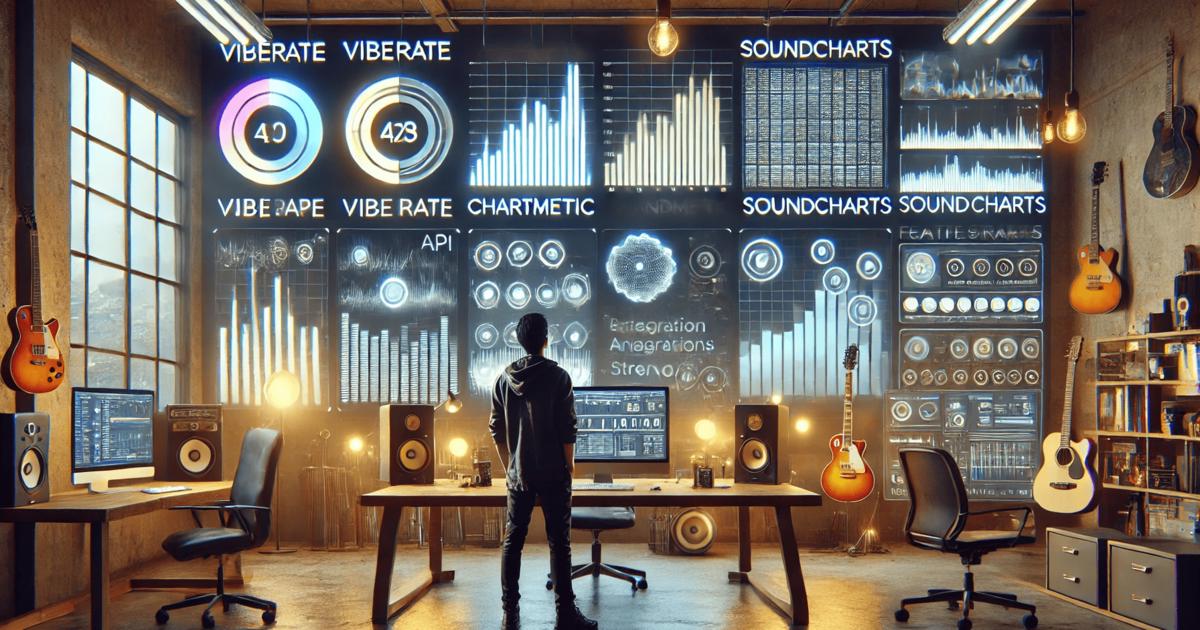Viberate vs Chartmetric vs Soundcharts: Best API for Music
Viberate vs Chartmetric vs Soundcharts: Best API for Music
In today's fast-moving music industry, staying ahead means having quick, reliable access to vast amounts of data. Artists, managers, record labels, and tech developers all rely on accurate music and audience analytics to make informed decisions. But manually gathering and analyzing this data across dozens of platforms can be overwhelming. This is where having access to a powerful API for music can change the game. With the right API integration, you can automate data collection, streamline artist management, and improve your overall strategy with real-time insights.
When it comes to choosing an API for music, pricing is an important factor. Viberate's API service starts at €300 per month, providing 60 calls per minute and 3 months of historical data. Chartmetric’s Developer API starts at $350 per user per month, billed monthly, and supports one request per second. Soundcharts, meanwhile, offers customized pricing upon request. Each platform offers a different structure depending on your business size and data needs.
Why an API for Music Is Essential for Artist Management
Managing artists today is not just about scheduling gigs and promoting new releases. It’s about understanding audience behavior, tracking social media engagement, monitoring streaming performance, and spotting trends before they happen. An API for music allows you to access and integrate this data directly into your internal systems, apps, or dashboards. Instead of manually updating artist profiles or tracking stats, APIs deliver fresh data daily, giving you the freedom to focus on strategic tasks.
Exploring Top API Providers for Music Data
Viberate: Music API with the Highest Data Integrity
Viberate’s API for music provides access to daily-refreshed data from millions of artists, tracks, playlists, festivals, and other industry entities. It covers Spotify, YouTube Music, TikTok, and various social media platforms. With over 11 million artists, 100 million tracks, 19 million playlists, 6,000 festivals, and 100,000 labels mapped, Viberate delivers one of the most comprehensive music datasets available.
What makes Viberate particularly reliable is its curated database, ensuring that each artist has only one unique profile. This eliminates the risk of data duplication, which can skew reporting and analytics. The "one artist = one profile" guarantee reflects Viberate’s focus on data integrity.
The flexibility of the Viberate API means it’s useful across different areas of the music business. Talent agencies can automatically feed gig dates and important metrics into artist profiles. Collecting societies, publishers, and distributors can enhance their reporting tools and offer better analytics to clients. Labels can refine A&R searches using advanced filters. And developers needing a Spotify or YouTube Music API can power their apps with rich content that updates automatically.
With competitive pricing, Viberate’s music API is accessible for startups and large enterprises alike, making it an excellent choice for those seeking reliable, scalable music data solutions.
Chartmetric: Proprietary Metrics and Custom App Building
Chartmetric’s API for music stands out by providing a wide array of proprietary metrics designed to give a clear, strategic view of an artist’s career. Their "Career Stage Score," "Recent Momentum Score," "Network Strength Score," and "Hot Rankings" allow users to gauge not just current performance, but future potential.
Covering over 9 million artists globally, Chartmetric offers access to track, album, playlist, and live performance data. Their database is not only broad but also deep, offering five years of historical data. This allows users to analyze past trends and make data-backed decisions about future investments and marketing strategies.
The Developer API enables users to build custom applications and solutions powered directly by Chartmetric's dataset. For tech teams looking to innovate, this API for music opens the door to truly personalized tools for artist management, marketing campaigns, and A&R decision-making.
Soundcharts: Real-Time Global Insights and Data Independence
Soundcharts takes a different angle, focusing heavily on delivering real-time data from a massive range of sources. Their API for music covers 12 million artists and 54 million songs, pulling from over 26,000 charts, 7 million playlists, and 2,400 radio stations worldwide.
Soundcharts has a strong emphasis on data cleaning and matching, ensuring consistency even when artist names, track titles, and languages vary. This linguistic and cross-platform matching approach helps tech and data teams work with highly accurate datasets.
An interesting feature of Soundcharts’ offering is the ability to cross proprietary company data with Soundcharts' database. This enables advanced analytics use cases like consumption pattern recognition, financial planning, and building custom A&R charts. With up to 7 years of historical social data and 5 years of radio airplay information, Soundcharts offers a rich archive for deeper analysis.
For teams that need scalable, independent data feeds, Soundcharts’ API can provide the foundation for innovative music business tools and applications.
Choosing the Right API for Music
Selecting the best API for music depends largely on your specific needs. If data integrity and a curated, duplication-free artist database are your priorities, Viberate’s API might be your best choice. For those looking for advanced proprietary metrics and a long historical view, Chartmetric’s Developer API offers powerful tools for strategic decision-making. And if your focus is on massive real-time datasets and integrating external data for advanced custom analytics, Soundcharts’ API provides a flexible, scalable solution.
In all cases, integrating an API for music into your systems can greatly enhance the efficiency of artist management. From boosting A&R activities to powering new apps and improving audience insights, the right API transforms how you manage and grow your roster.




